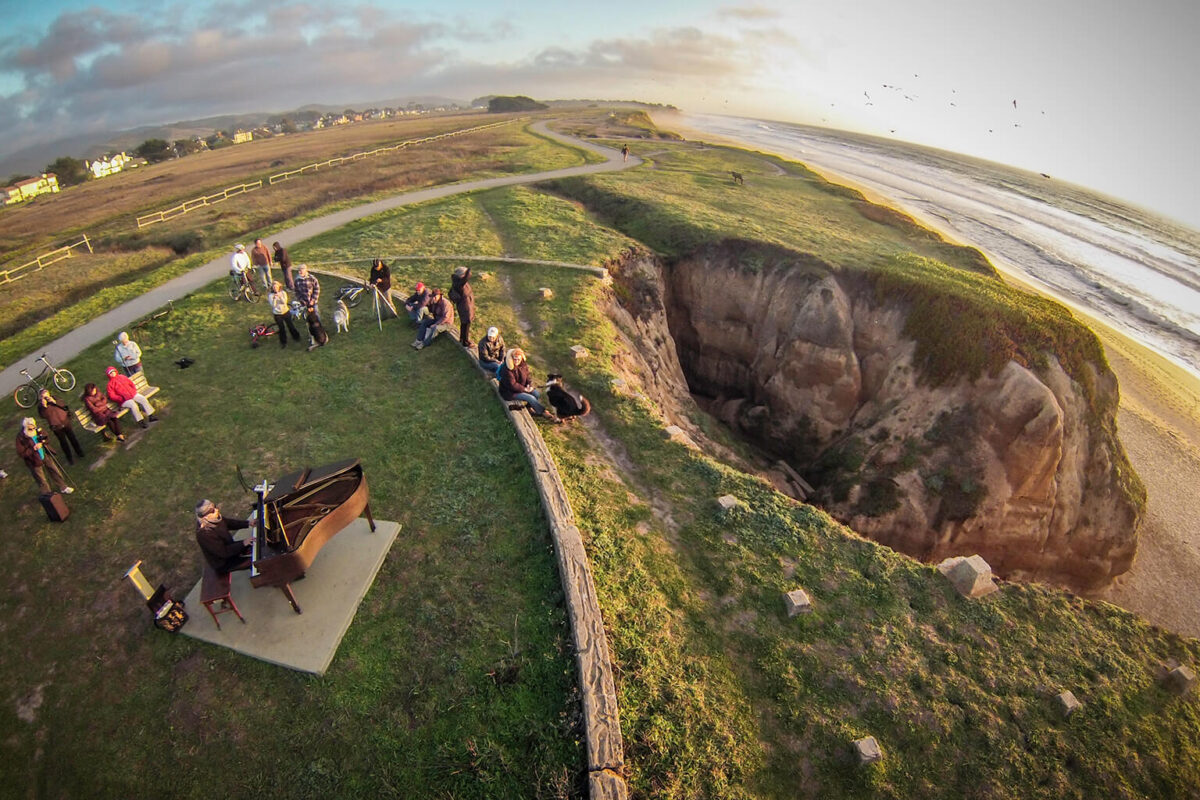Words by Johanna Harlow
A baby grand trundles along a bluff in Half Moon Bay with assistance from several men and a wheeled dolly. As it jostles and judders along the uneven ground, the piano makes musical noises of protest as if to say, “I’m too old for this kind of thing”—but it changes its tune when it reaches a wildflower outcrop overlooking the sea. As soon as a player raises its keylid, the instrument begins harmonizing with a choir of seagulls, keeping tempo with the waves. It’s hard to imagine this wild mahogany beast ever returning to a domestic existence in some parlor, quietly collecting dust.
“We all think you go to a concert hall or somebody’s living room to hear someone play the piano—so you take it out of that context, and it makes people think,” says Mauro ffortissimo, an artist with expressive hands befitting one who grew up tickling the ivories.
Before immigrating to the U.S. at 18, Mauro grew up under Argentinian dictatorship rule. He was making music before he could read chapter books. “My mom played piano,” he relays. “I started when I was five. At six, I went to a conservatory.” As time passed, Mauro felt compelled to engage with the instrument in more ways than hands on keys. The piano became a muse, a source of inspiration for performance art and sculptures.
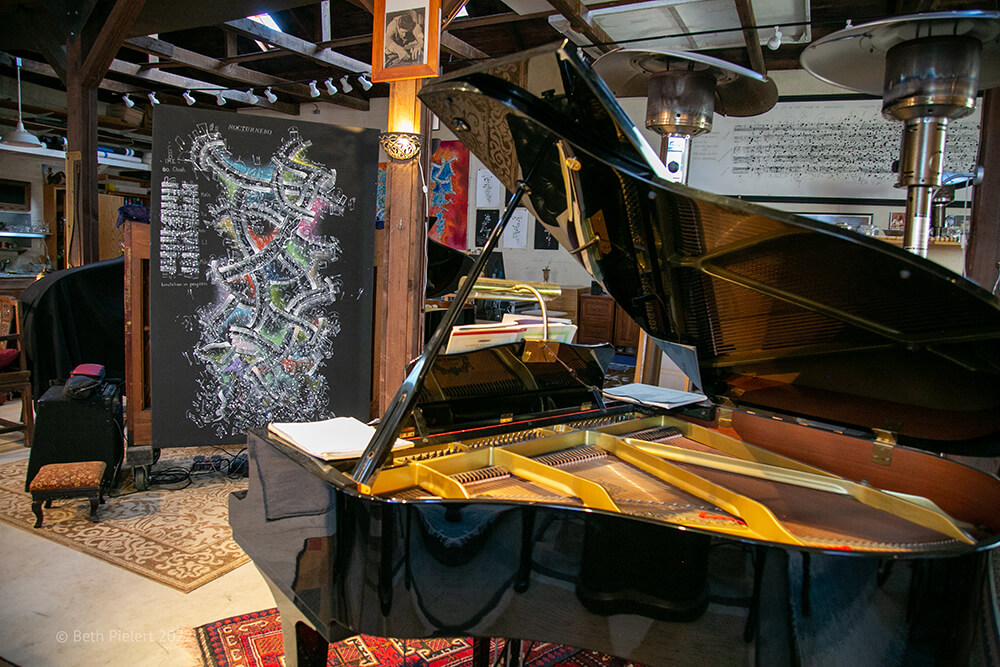
To Mauro, a piano’s body is as alluring as its voice. “I love the insides, the mechanisms,” he explains. As he rakes his fingers through his hair, it sticks up exactly like the Beethoven bust in his studio. “It’s just insane the amount between you pushing the key and the actual hammer. There are over a thousand parts—tiny pieces of wood, levels, springs, you name it!”
It’s this mindset that drove him to refigure the percussion instrument into a stringed form by removing the keyboard and hammers, then turning the soundboard and its wires upright like a harp. Mauro adds fishing line and brass tubes to further “free it from the 12-tone scale” and make more opportunities for unique sounds. When he plucks the strings, squeezes the tubes and taps the wires with a cork-topped baton, the result sounds like a harp, hammered dulcimer, violin and whale all rolled into one. “I fire the orchestra,” Mauro laughs. He calls it his Piano Liberado.
When Mauro alters a piano these days, he’s got the procedure down pat. “I do it really quick—in a couple hours,” he boasts. “It requires a couple big screwdrivers and a sledgehammer.”
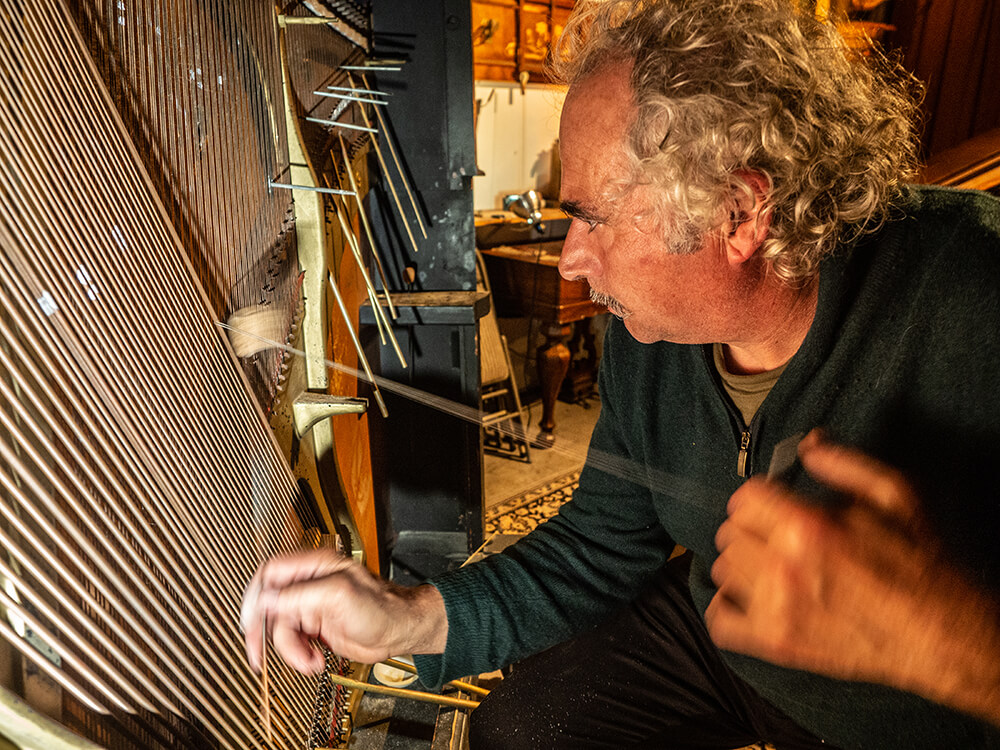
Like a huntsman deftly gutting an animal, Mauro makes sure to preserve the piano’s many parts, wasting nothing. They will be stored in a tall tower of baker’s racks until he needs them for one of his other sculpture projects. Keyboards become black and white waves. Emptied piano bodies get stacked into columns. Hammers weave into hanging mobiles or bouquets of flowers. Steel frames decorate the backyard fence.
Mauro knows not everyone condones his treatment of these instruments. But some pianos are simply beyond a tuneup. And to him, it’s a conversion, not a dissection. “They go to the dumps all the time,” Mauro points out. “I give them another life.”
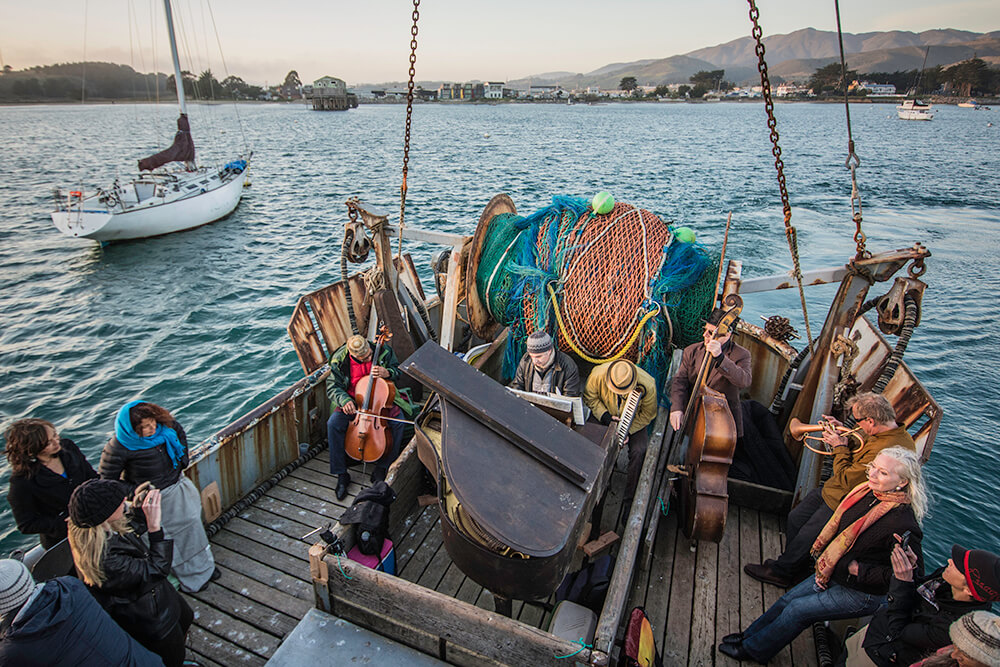
Piano as Performance Art
Plenty of instruments in Mauro’s care remain intact for his performance art. These projects fall under the umbrella of Sunset Piano—an ongoing series that involves “placing extremely heavy musical instruments in unexpected places.”
Founded in 2013, Sunset Piano is the collaborative effort of Mauro and his fedora-wearing filmmaker pal Dean Mermell (who is also a musician and art lover). The two were introduced by renowned Burning Man artist Pepe Ozan. “I remember him saying, with a very meaningful look, ‘You two should know each other,’” Dean recalls.
For their first collaboration, Dean filmed Mauro and his “piano ninjas” as they navigated pianos to impossible places up and down the coast, from Pacifica to Santa Cruz. Pros and novices came to play Chopin and “Chopsticks” for the passing porpoises and sea lions. “A kid might be too shy to play at home in the living room with the grandparents looking,” muses Mauro, “but now he’s sitting there and there’s a goose going by, and he thinks, ‘Okay, I can play this!’”
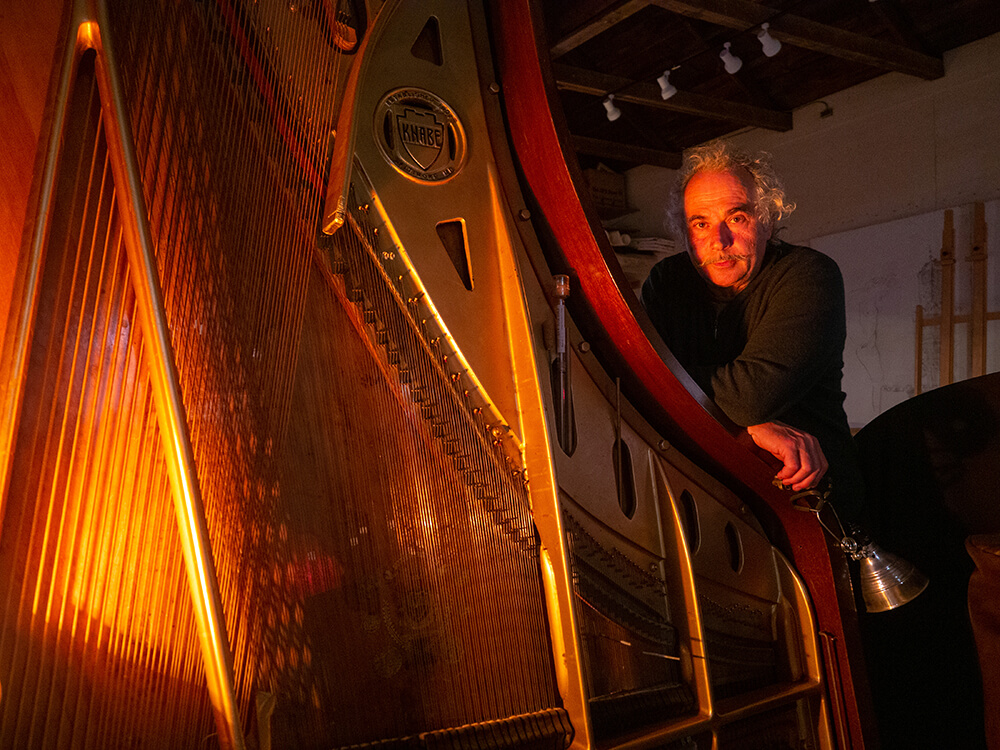
Musicians, singers, poets, fire dancers and lyra aerial hoop dancers also contribute. An enchanting evening might involve a wordsmith spitting verse beside a crackling bonfire or a woman twisting and twirling through a hoop suspended in the cypress branches.
Twelve Pianos, Dean’s documentary of the entire escapade, premiered at San Francisco’s Green Film Festival. “Mauro and I share a pretty wacky artistic vision, but we’re also both very practical people who like to figure out how to get things done,” Dean shares. “It’s really all about getting the music out there, and providing a space for wonder to happen. We need more wonder—that’s kind of the business we’re in.”
The two have continued to cook up crazy ideas—and Dean has played a pivotal role in producing and documenting their projects together (handling their online presence as well as filming). Meanwhile, Mauro tackles things hands-on (or as he colorfully puts it: “I build shit.”) He’s in his element wheeling pianos along grimy Tenderloin streets to play for the homeless and hopping aboard a fishing boat to serenade the migrating humpback whales. “Fortissimo” (a musical term for playing a piece loudly—and his chosen surname) certainly fits Mauro’s commitment to evade quiet living.
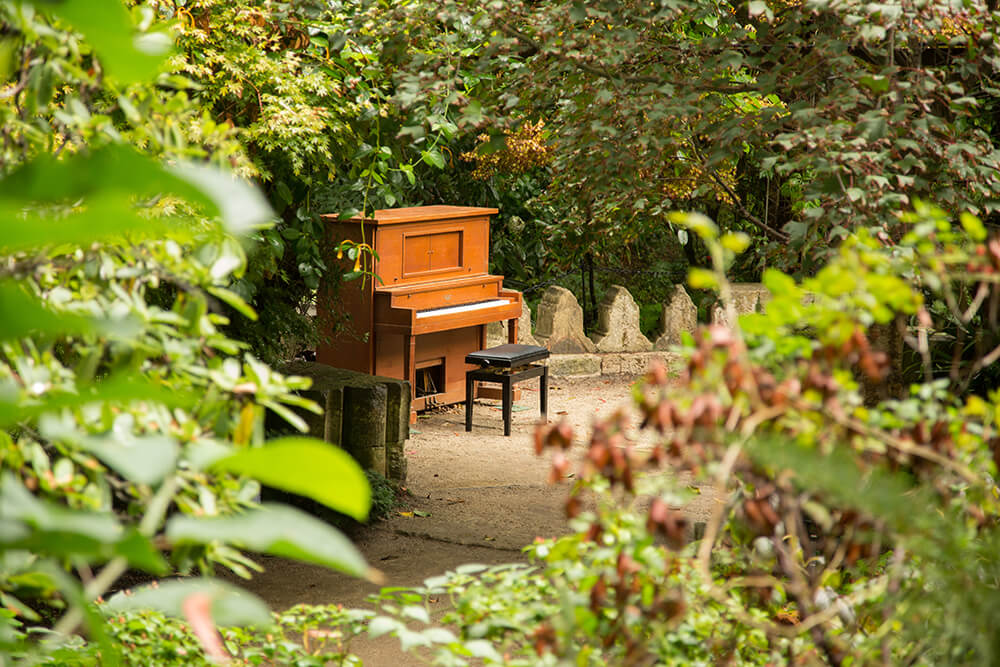
The partners also brought Flower Pianos to the San Francisco Botanical Garden, an event that tucks 12 pianos and over 50 performers throughout the luscious greenery of the park. Guests follow enchanting strains of music filtering through the trees from one location to the next—from a meadow to a redwood grove, from an arbor brimming with flowering perennials to a pond-side platform. “There’s just something about nature and music—both awe-inspiring in their own right—that causes them to elevate each other,” notes Mauro. (Keep an eye out for the event’s return this September).
Good Vibrations
During one cliffside concert, Mauro set a piano on fire. When the story hit the media, some were outraged. But what they called “destruction,” Mauro considered a “cremation ceremony.” “It’s all temporary,” Mauro reflects. “It’s not dying, it’s just converted to another thing. It’s a sculpture now.” He motions at the blackened form of the piano in question, which sits in a corner of his studio, tenderly adorned in tea lights. “Music is beyond time. It doesn’t die.”
Over 60 people have entrusted Mauro with their retired Steinways and Yamahas. They seem to understand that for Mauro, music isn’t just a pastime—it’s a way of life. And his Half Moon Bay studio stands testament. A gutted piano serves as a planter bed outside, while his oddly-shaped coffee table lived its previous life as a piano lid. Mauro’s massive paintings cover the walls and feature musical notes—which splash across the canvas like ink blots in a particularly passionate love letter. There’s deep respect there.
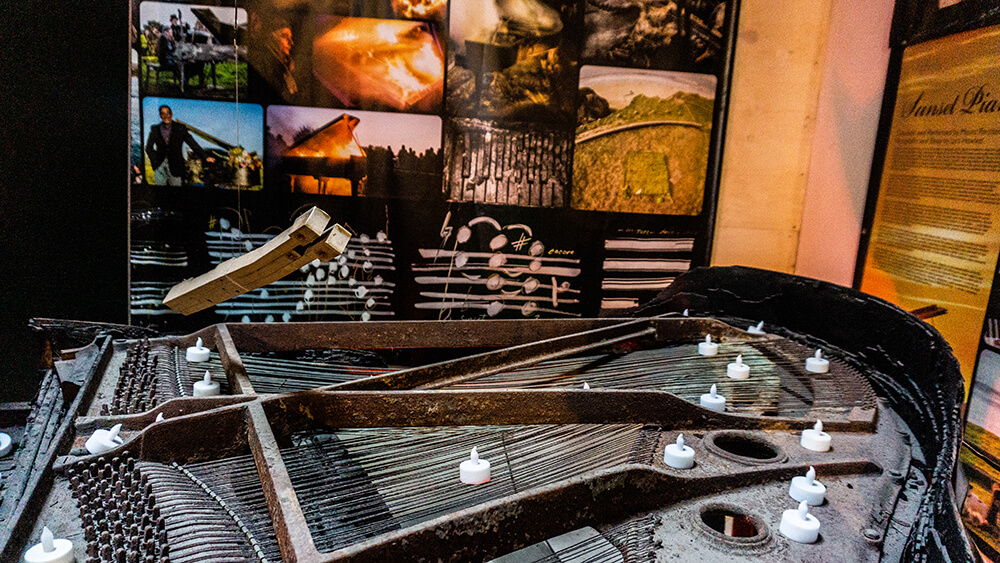
Keyboards on the other hand, haven’t earned Mauro’s esteem. “They’re cold and plastic,” he shudders. “A lot of the electronic stuff… after three, four or five years, they’re gone. Like a cellphone, you need to upgrade and buy a new one.” Continuing these musings, he adds, “To me, music is not about sounds only. When you play an acoustic instrument, there’s vibrations. It’s a human aspect. It’s a physical thing. If you stand in front of the piano and you pluck the bass strings, you feel it in your guts.” Take one of his largest sculptures to date: a booth of galvanized metal, lined in piano soundboards. When someone steps inside this “music box” to pluck the walls and ceiling, they are met by a storm of sound that reverberates under their feet.
No matter the setting and whatever its form, a piano in Mauro’s hands is infused with intense emotion and rich history. “It’s alive,” he asserts, “and it is full of memories of things alive.”


